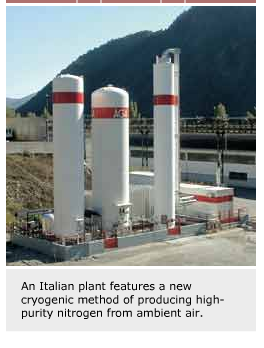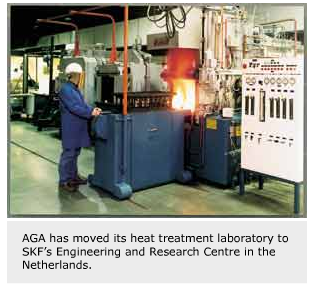
Partnership offers opportunities in heat treatment
Heat treatment is a vital operation in bearing production. It requires both engineering and gas technology expertise. To strengthen and support the process, SKF and the industrial gas group AGA have teamed up to combine their research and development resources.
Bearing production includes a key heat treatment operation to provide the desired mechanical properties. In practice, this process, called austenitisation, is carried out at a high temperature, typically around 860°C, for 15-20 minutes in a continuous furnace, followed by quenching and tempering. During the hardening process no oxidation of the bearing components should occur, nor should there be any surface decarburisation.
These conditions are met by purging the furnaces with an atmosphere consisting mainly of nitrogen together with some carbon-containing gases. The control and composition of this furnace atmosphere is crucially important for the subsequent steps in the process and for the final bearing properties.
Naturally, as a major bearing producer, SKF is also a significant consumer of industrial gases. For example, in 1996, nitrogen consumption within its European factories was about 35 million cubic metres. Traditionally, the supply of this gas has been negotiated on a local basis involving many different suppliers and, consequently, variations in pricing and delivery conditions.
For some time, SKF has been seeking to rationalise and standardise this supply situation and has studied the potential benefits of supplier partnerships and group sourcing in this crucial technical area. By mid-1996, the Technical Development Centre for Heat Treatment together with Group Sourcing within SKF had formulated a plan for the future organisation of nitrogen supply, quenching media and furnace development.
Key to this plan was the definition of the critical heat treatment process steps, which have an impact on product properties. The aim was then to establish partnerships in R&D for each of the process steps in order to optimise heat treatment within SKF.
Such partnerships were determined to have cost-saving advantages, when a single best-in-class supplier was selected for protective atmospheres. Such a partner could contribute to SKF’s work regarding development of protective atmospheric control of furnaces.
Selecting a partner
Though the concept of supply partners was considered revolutionary by the gas industry, many participated in the selection process. Supplier criteria identified for successful partnership and secure gas supply included:
- worldwide representation with global supply capabilities;
- the offering of a complete solution wherein the supplier can take responsibility for the protective atmosphere, not just the gas;
- ability to deliver 24 hours a day, seven days a week;
- competence in furnace atmospheres and metallurgy and strength in developmental partnerships; and
- a competitive price.
The evaluation of suppliers started in September 1996. Five suppliers were selected for the short list. After several discussions and visits to each supplier, the number was reduced to two suppliers that had similar pricing strategies. Finally, AGA was selected on the basis of its technical capabilities and its collaborative approach to working with SKF factories.
In September 1997, SKF and AGA signed an agreement covering the commercial conditions for the supply of protective atmospheres and joint technical cooperation. AGA now supplies SKF within Europe and the intention is that AGA will take up global supply responsibilities. Practical measures included the formation of a steering group with regular meetings between representatives from the commercial and technical sides of both companies. These meetings follow up on agreed action plans and initiate new and improved ways of developing and deepening the cooperation, to the benefit of both companies. A common database has been implemented to facilitate communication.
Technical review
Before gas deliveries began, detailed technical reviews were carried out at different SKF plants by both companies. This was to ensure that the proper and most economical supply methods were defined for each factory. This review estimated that possible additional cost savings could be achieved, accounting for an extra 15 %.
It was found that, for most plants, a conventional liquid nitrogen supply system was the best technical and cost-effective solution. In plants where consumption of nitrogen is high, the production of nitrogen on-site is a better solution. The nitrogen production is based on a new cryogenic technique that can extract high-purity nitrogen from ambient air.
AGA has also started to provide direct support to a number of SKF factories. One has converted its production process from a methanol rich atmosphere to natural gas/nitrogen mixture. This has accounted for additional cost savings of around 30 percent.
The partnership experience has been very positive and the transition to a single gas supplier smooth and well supported. The partnership concept extends to joint R&D. Because the companies are not directly competing, resources in this activity can be effectively exploited. Over the past two years, a number of joint research and development programmes have been initiated. The main focus for both companies has been related to surface heat treatment processes and gas quenching of bearing components. Both companies also have joint R&D programmes at institutes and universities.
By working together, both companies can guide this research more effectively and, in turn, increase the success of this work by practical application.
To further the technical cooperation and increase the benefit of resource sharing, AGA has moved its heat treatment laboratory to the SKF Engineering and Research Centre at Nieuwegein in the Netherlands. By joining forces, combined capabilities have been strengthened and a first-class heat treatment laboratory has been created. Joint development of new and improved processes will help SKF to improve the quality, the productivity and the environment, as well as to reduce bearing manufacturing costs. For AGA, the benefits include the ability to offer customers better services involving gas-related technology. n
Anna Bolin
SKF Engineering and Research Centre (ERC), Nieuwegein, the Netherlands.







